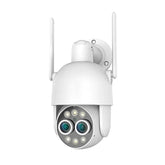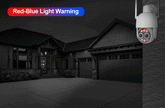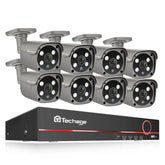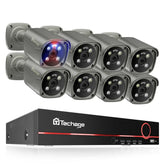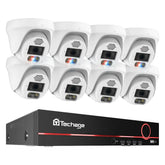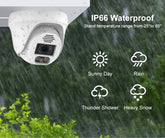De combien de stockage avez-vous besoin pour un système de caméra de sécurité ?
Lors de la mise en place d'un système de caméras de sécurité comme Techage , Reolink et d'autres marques, le stockage est l'un des éléments les plus importants à prendre en compte. Que vous surveilliez une petite maison ou une grande entreprise, il est essentiel de vous assurer que vous disposez de suffisamment de stockage pour capturer et conserver des images importantes. Mais quelle est la quantité de stockage suffisante ? La réponse dépend de plusieurs facteurs, du nombre de caméras à la résolution et aux paramètres d'enregistrement. Dans ce guide, nous détaillerons tout ce que vous devez savoir pour calculer vos besoins de stockage et trouver la meilleure solution pour votre kit de sécurité.
Facteurs clés qui affectent les besoins de stockage
Plusieurs variables influencent la quantité de stockage dont votre système de sécurité aura besoin :
1. Nombre de caméras
Chaque caméra de votre système génère des séquences vidéo qui contribuent au total des données stockées. Plus il y a de caméras, plus il y a de données. Les besoins en stockage évoluent donc directement en fonction du nombre de caméras de votre configuration.
2. Résolution des caméras
Les caméras à haute résolution, comme la 4K, produisent des fichiers vidéo plus volumineux que les options à faible résolution comme la 1080p. Si les résolutions plus élevées offrent des images plus claires, elles nécessitent également beaucoup plus d'espace de stockage.
3. Fréquence d'images d'enregistrement
La fréquence d'images, mesurée en images par seconde (FPS), affecte la fluidité de la vidéo. Des fréquences d'images plus élevées (par exemple, 30 FPS) entraînent des tailles de fichier plus importantes par rapport à des fréquences d'images plus faibles (par exemple, 15 FPS).
4. Technologie de compression
Les caméras modernes utilisent des codecs de compression tels que H.264 ou H.265 pour réduire la taille des fichiers sans sacrifier la qualité vidéo. Le H.265 (HEVC) est plus efficace que le H.264, permettant d'économiser jusqu'à 50 % d'espace supplémentaire.
5. Mode d'enregistrement
- Enregistrement continu : enregistre 24h/24 et 7j/7, consommant le plus d'espace de stockage.
- Enregistrement déclenché par mouvement : enregistre uniquement lorsqu'un mouvement est détecté, réduisant ainsi considérablement les besoins de stockage.
- Enregistrement programmé : permet des heures d'enregistrement spécifiques, équilibrant l'utilisation du stockage et la disponibilité.
6. Période de conservation
La durée de conservation des séquences vidéo aura une grande influence sur vos besoins de stockage. Par exemple, le stockage de séquences pendant 7 jours nécessite beaucoup moins de stockage qu'une période de conservation de 30 jours.
Comment calculer vos besoins de stockage
Pour estimer vos besoins de stockage, utilisez la formule suivante :Stockage (Go) = Débit binaire (Mbps) × 3600 × Heures par jour × Jours de rétention ÷ 8 ÷ 1024
Variables expliquées
Débit binaire (Mbps) : Débit binaire vidéo par caméra, déterminé par la résolution, la fréquence d'images et la compression.
3600 : nombre de secondes dans une heure.
8 : Convertit les bits en octets.
1024 : convertit les octets en gigaoctets (Go).
Cette formule donne l'espace de stockage nécessaire pour une caméra. Multipliez-la par le nombre de caméras de votre système pour obtenir l'espace de stockage total requis.
Exemples de scénarios
Voici quelques configurations de caméra courantes et leurs exigences de stockage pour vous donner une image plus claire :
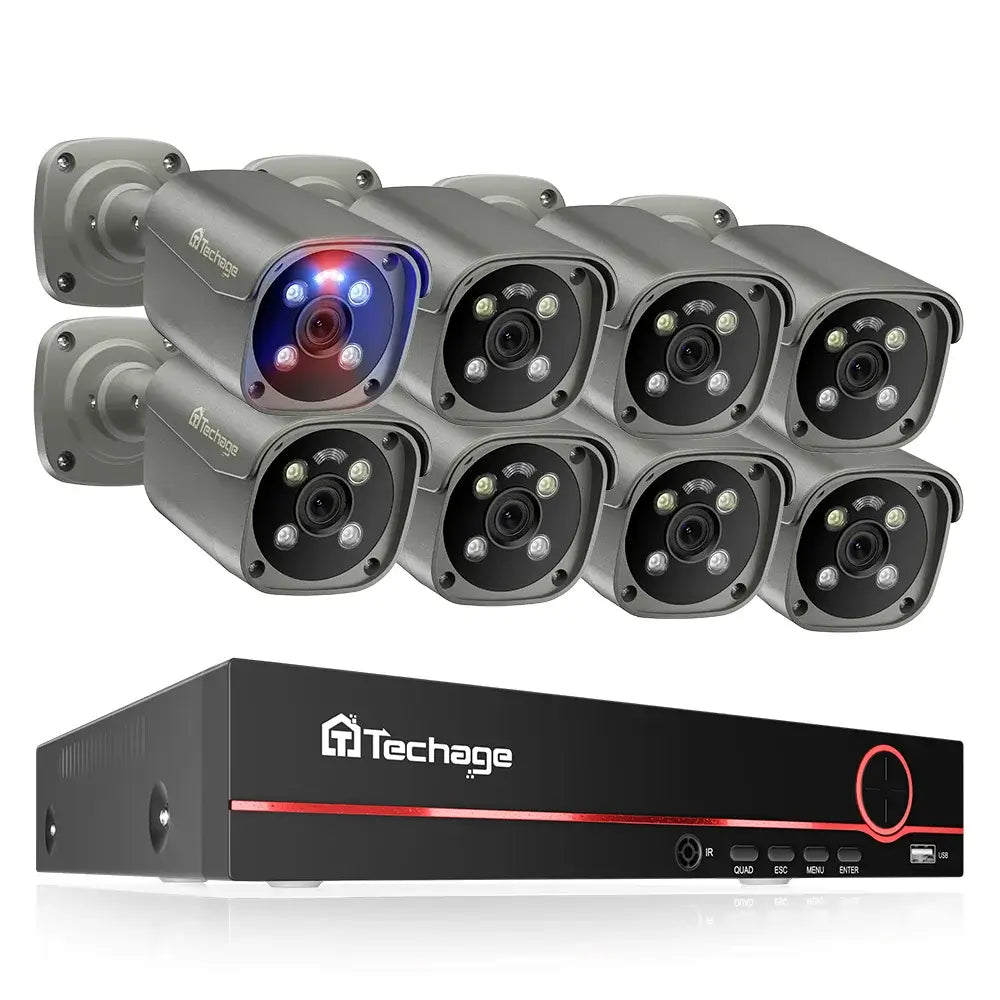
Système de caméra POE 4K 8MP prenant en charge la détection humaine dans les véhicules
Système PoE Plug and Play stable avec enregistrement continu 24h/24 et 7j/7
Apprendre encore plus1. Système de caméra PoE 8 canaux avec résolution 4K
Configuration : 8 caméras, résolution 4K, 15 FPS, compression H.265.
Mode d'enregistrement : enregistrement continu, 24 heures/jour.
Durée de conservation : 7 jours.
Débit binaire : 5 Mbps par caméra.
Stockage quotidien par caméra (Go) = 5 x 3600 x 24 ÷ 8 + 1024 ≈ 54 Go
Stockage total = 8 x 54 x 7 = 3 024 Go ≈ 3 To
Résultat : vous aurez besoin d’au moins 3 To de stockage pour ce système.
2. Système de caméra de sécurité 16 canaux avec résolution 5MP
Configuration : 16 caméras, résolution 5MP, 20 FPS, compression H.265.
Mode d'enregistrement : enregistrement déclenché par mouvement, actif 50 % du temps.
Durée de conservation : 14 jours.
Débit binaire : 4 Mbps par caméra.
Stockage quotidien par caméra (Go) = 4 x 3600 x 24 + 8 ÷ 1024 ≈ 43,2 Go
Considérant que l’enregistrement de mouvement réduit le stockage de 50 % :
Stockage ajusté par caméra (Go) = 43,2 x 50 % = 21,6 Go
Stockage total = 16 x 21,6 x 14 = 4 838,4 Go ≈ 4,8 To
Résultat : vous aurez besoin d’environ 5 To de stockage pour ce système.
3. Système de caméra 32 canaux avec résolution 5MP
Configuration : 32 caméras, résolution 5MP, 25 FPS, compression H.265.
Mode d'enregistrement : enregistrement continu, 24 heures/jour.
Durée de conservation : 15 jours.
Débit binaire : 6 Mbps par caméra.
Étape 1 : Calculer le stockage quotidien par caméra
Stockage quotidien par caméra (Go) = 6 Mbps x 3600 x 24 ÷ 8 ÷ 1024 ≈ 64,8 Go
Étape 2 : Calculer le stockage total pour 32 caméras sur 15 jours
Stockage total = 32 caméras x 64,8 Go/jour x 15 jours
Stockage total = 32 x 64,8 x 15 = 31 104 Go ≈ 31 To
Résultat : vous aurez besoin d’environ 31 To de stockage pour ce système avec une période de conservation de 15 jours.
Des solutions de stockage pour différents besoins
1. Stockage local
Utilise des disques durs ou des SSD dans les NVR ou les DVR.
Idéal pour les configurations de petite à moyenne taille.
Avantages : Accès immédiat, pas de dépendance à Internet.
Inconvénients : évolutivité limitée.
2. Stockage dans le cloud
Stocke les images à distance sur des serveurs cloud.
Idéal pour les utilisateurs ayant besoin d’un accès à distance et d’évolutivité.
Avantages : Accessible de partout.
Inconvénients : coûts d’abonnement et dépendance à Internet.
3. Solutions hybrides
Combine le stockage local pour un accès en temps réel avec le stockage cloud pour la redondance.
Convient aux configurations moyennes à grandes.
Conseils pour optimiser l'utilisation du stockage
- Activer la détection de mouvement : réduit les enregistrements inutiles et économise de l'espace.
- Utilisez la compression H.265 : compresse efficacement la vidéo sans sacrifier la qualité.
- Examinez régulièrement les séquences : supprimez les séquences inutiles pour libérer de l'espace.
- Mise à niveau du matériel : investissez dans des disques durs plus grands ou des systèmes RAID selon vos besoins.
Conclusion
Il est essentiel de calculer les besoins de stockage de votre système de caméra de sécurité pour garantir un enregistrement continu et fiable. En comprenant les facteurs clés tels que la résolution, le débit binaire et les modes d'enregistrement, vous pouvez déterminer la solution de stockage idéale pour votre configuration.Qu'il s'agisse d'un petit système à 8 caméras ou d'une grande installation à 32 caméras, des calculs précis vous aident à planifier à l'avance et à éviter de manquer d'espace. Utilisez les exemples et les conseils ci-dessus pour concevoir un système qui répond à vos besoins sans vous ruiner.
Investir dans un stockage évolutif et de grande capacité garantit que votre système reste fonctionnel et que vos images sont toujours disponibles lorsque vous en avez le plus besoin !




